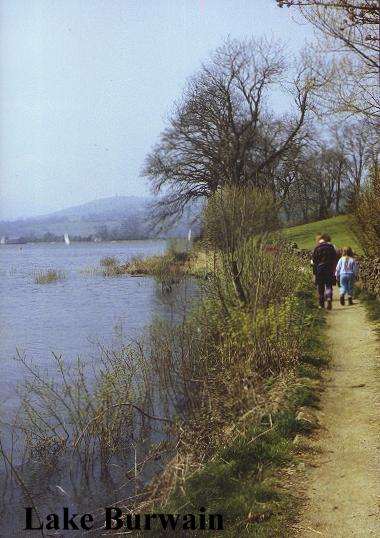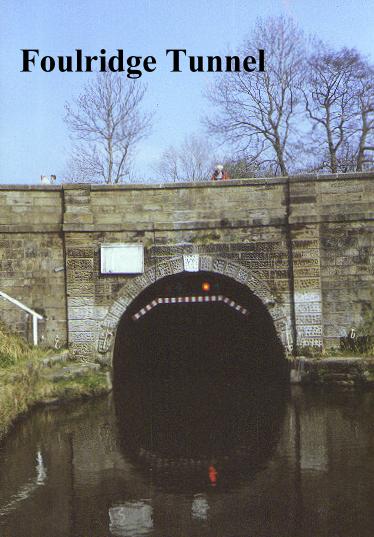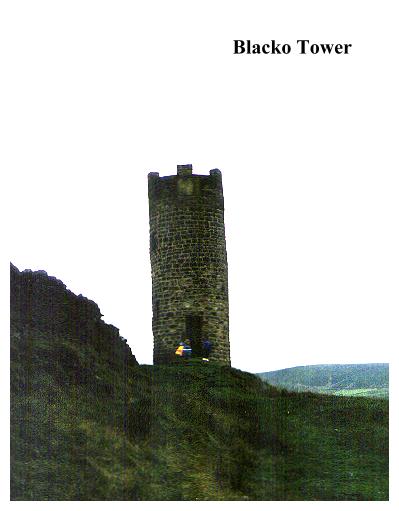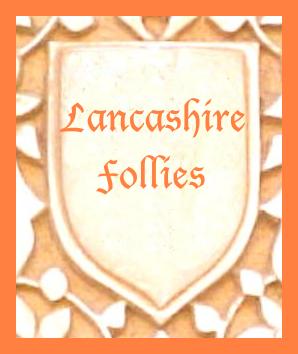1. BLACKO TOWER
Ghosts,'leggers' and witches are the main themes of this excellent walk on the bracing uplands twixt Pendleside and the Aire Gap.
Getting There:Take the A56 Burnley-Skipton road to Foulridge, north of Colne. Turn onto B6251 for a few hundred yards before bearing right down Warehouse Lane to the canalside, where there is a car park, shop and cafe.
Distance: 5 miles approx. Moderate.
Map Refs: Start SD 888 428 (Sheet 103)
Blacko Tower SD 859 422 (Sheet 103)
Rating:Walk*** Follies and General Interest**
Foulridge is an ideal start for a ramble - an interesting little place, which manages to be both an industrial community and a rural backwater at the same time. Its fortunes were originally founded on woollen textiles, and many of the houses in the older parts of Foulridge belong to this period. Today, Foulridge's main asset is its position on the main Skipton-Burnley trunk road, but the village really owed its identity to the coming of the Leeds and Liverpool Canal at the end of the eighteenth century. This fact is readily acknowledged by the recent development for tourism of Foulridge Wharf.
Foulridge plays host to the canal's two main feeder reservoirs. Foulridge Lower Reservoir, also known somewhat exotically as Lake Burwain, was constructed in 1793, the canal wharf and warehouse being built somewhat later, in I815.

The real wonder of Foulridge, though, is the mile long canal tunnel which runs to the north-west of the lake, and which (in the days before they mucked the boundaries up) carried boats from Yorkshire into Lancashire.
Before proceeding on our walk we must visit the entrance to the tunnel. Our walk in fact visits both ends of the tunnel, and follows it on the surface for much of its distance. There is little to see at the Foulridge end. The intrepid will lean out from the iron rail set into the tunnel mouth, but all you are likely to see is darkness, and all you will hear is the eerie drip of dank waters. The surround of the tunnel mouth is carved with weird hieroglyphs. These are the ornamentation made by the predominently Irish navvies who constructed the canal.
The tunnel runs straight, but you cannot usually see the other end. I have seen it once from the 'Lancashire' end, a tiny distant pinprick of light, but I did not see it on my last visit. The tunnel has subsided, as is evidenced by the 'roof height' marker which hangs over the tunnel mouth. Perhaps this is a factor in obscuring the view.
I must confess to a love/hate relationship with the Foulridge Tunnel. I have navigated it twice - once in a small boat and once in a kayak. In a small boat it is fascinating and enthralling, in a kayak, with only a bike lamp for illumination, it is terrifying! The echo inside is phenomenal - every tiny sound is picked up, amplified and carried the full length of the tunnel. The yell when you crash into the wall in the darkness and narrowly avert a capsize, is carried up and endlessly echoed. The light from the airshafts brings a welcome respite, and as your eyes gradually adjust to the darkness, the far end gradually appears, a dirty yellow-green swirling blotch, small and distant beyond the dank mist that rises from the gurgling waters. When, with a sigh of relief you get into the 'light zone' at the far end, the reflection of the tunnel roof in the waters becomes perfect, and you have the weird sensation of flying through the centre of an enormous tube.

The Foulridge Tunnel is unusual in that it was not bored but dug out from the surface, a deep cutting being excavated, roofed over and then buried.
The tunnel was completed in 1796, although it was not until 1815 that the canal was completed along its full 127 miles. The tunnel has no towpath, and in the days before powered boats the horses had to be walked over the top, and the boat 'legged' through the tunnel, a gruelling occupation involving lying on a special platform and pushing along the tunnel wall with your legs. There is now a one-way traffic light system, which operates on a time switch. In the adjacent Hole in the Wall pub, a photograph records a memorable incident in 1912 when a cow fell into the cut at the Barrowford end of the tunnel and swam right through to Foulridge, the exhausted animal apparently being revived with alcohol!
Our walk proceeds up through Foulridge, before following a footpath through housing to the shores of Lake Burwain. A pleasant footpath runs around the edge of the lake, and up on the distant hillside, Blacko Tower, the object of our walk, is in full view.
On the far side of the lake is haunted Hobstones Farm. The house has the unsavoury reputation of being one of the most haunted houses in Engand. Even its name is suggestive of something supernatural. 'Hob' is an old Saxon word for hobgoblin, an evil troll or elf, and it is well-known that elves and fairies congregated at 'the stones'. There is reputed to be a prehistoric burial ground in the vicinity of Hobstones Farm, and even the reservoir,- Burwain - takes its name from an old English word meaning 'burial ground'.
Hobstones is essentially a fifteenth or sixteenth century farmstead which was entirely rebuilt in the eighteenth century. The property was once owned by the Parker family of Alkincoats near Colne, and there is a story that Colonel Parker, who was a royalist, once engaged in a short but bloody skirmish with a Parliamentary force at Hobstones during the Civil War. Since then people have supposedly seen a phantom troop of Roundheads crossing the nearby fields, fully armed with muskets and pikes. A more serious haunting at Hobstones, however, began back in the 1950s when a tenant farmer was quite literally caught with his pants down! He was sitting in an outside lavatory one morning when the door suddenly burst open and he was confronted by the figure of a dwarfish man, dressed in monk-like robes with a twisted face. He held out a bleeding arm, the lower part of which had been severed from the elbow. As the farmer sat there, frozen with horror and astonishment, the figure simply vanished.
There was no logical explanation for this apparition. Certainly no monastery ever existed at Hobstones, but there is a theory that some of the stone used in the 18th century rebuilding may have come from Sawley Abbey, which was cruelly repressed during the dark days of the Dissolution.
The next spate of hauntings came in the 1970s, when the house was beset by poltergeist activity. There were bumps and thumps, objects moved inexplicably and a washing machine flung across the kitchen. Glass panes were shattered, smashed out from the inside, the glass ground to a powder. On one occasion a pile of rocks came tumbling down the stairs from the upstairs landing, from where they had come nobody knew, and on another a ghostly giant fist was seen pounding the front door.
Matters came to a head on the night of 29th September 1974, when the house was shaken almost to its foundations by what the local press salaciously described as 'wailing demons!' The Rector of Colne the Rev. Noel Hawthorne was brought in, along with a skilled exorcist. Rituals were performed, holy water sprinkled and the hauntings progressively died down.
Our appetite for the supernatural whetted, we continue on our way, and having inspected the far end of the Foulridge Tunnel we proceed up the hillside to Malkin Tower Farm. Here yet more supernatural fare awaits us, for somewhere in the vicinity of this embattled farmhouse once stood Malkin Tower, the meeting place of the Pendle witches. The name 'Malkin' is unusual and interesting, and research would suggest that the word means 'scarecrow' or simply 'untidy'.
The actual location of Malkin Tower - the hovel where Old Demdike the supposed leader of the witches, lived, has long been a subject of dispute. Some sources say it wasn't here at all, being actually located near Sadlers Farm at Newchurch-in-Pendle. Other writers speculate that it actually stood on the side of Blacko Tower, which we are shortly to ascend. Wherever it was, one thing is certain: on Good Friday 1612, a meeting was convened there of the friends and relatives of Demdike, Chattox, Anne Redfearn and Alizon Device, all of whom had just been sent to Lancaster Castle to await trial on charges of witchcraft. It was a fateful meeting which was to result in the arrest and subsequent condemnation of many of those who attended. It was not, as was alleged, a witches feast - rather a gathering of fearful people, who having heard of the arrest of their relatives were desperately trying to decide what to do next.
It is not my intention to delve too deeply into the story of the Pendle Witches. The story is well known, and does not need to be retold by me. Our business is the discovery of follies and beyond Malkin Tower Farm our search is soon rewarded, for there, high above on our right we can suddenly see the gaunt outline of Blacko Tower.
Blacko (or Stansfield) Tower circular roughstone prospect tower which was built around 1890 by one Jonathan Stansfield, a local grocer, who according to the story hoped to see over into Ribblesdale from it, only to find that when completed it was not high enough, and he was left with a useless 'folly'. One day in 1964 the sun rose over the hills to disclose a tower that had been mysteriously whitewashed during the night! Who did it, and why?? Many years ago a Bronze Age axehead was found near here, which was dated at about 3,500 years old. No one seems to know much about Blacko Tower - it is a place of mysteries.

Certainly people have had a few strange ideas about Blacko Tower. According to Guy Ragland Phillips, the antiquarian, the site is a point from which mysterious 'straight track' alignments, or 'leys', radiate in all directions. Apparently these tracks correspond to 'earth currents' and may be detected by dowsing. I certainly did not feel any 'vibrations' when I was there, and neither, I suspect did old Jonathan Stansfield.
The view from the tower is, as Stansfield found to his cost, not as extensive as one would like. Pendle Hill dominates the western prospect, and, as we already know, there is no view over into Ribblesdale. Southwards, towards the Nelson-Colne conurbation, there is an excellent prospect, but beyond the view is again blotted out by the Yorkshire South Pennines, ranging from Boulsworth Hill to Pinhaw Beacon. This does not detract from the tower, however, which for some mysterious reason seems to be excellently sited. There is the feeling that if there was no tower at this location, someone would almost certainly take it into his head to build one. And what of Stansfield's tower? A datestone over the tower bears the following biblical reference: PS 127 VI. The Psalm to which this refers is well known:
'Except the Lord build the House they labour in vain that build it
Except the Lord keep the city, the watchman waketh but in vain'
So was Blacko Tower built to satisfy the eccentric whims of a Lancashire grocer, or was there a more subtle purpose behind its construction? Was it perhaps a latter-day attempt to sanctify a pagan site, or to erase the suggestion that it was once a gathering place of witches? Who knows? Whatever the case, when moon is full and the wind howls through the weathered stones, no doubt the shade of poor Stansfield haunts the turret, desperately trying to look over the hill to the sea, and to prevent the Devil from stealing his tower.
Our walk now proceeds back to Foulridge, but not by the same route we came. Beyond Peel's House, we follow an upland track along Lister Well Road, with heather moors on both sides and fine sweeping views towards the Aire Gap, and, at the top of the rise, to Three Peaks country. Our descent to the canal (via a pint at the Fanny Grey) is not without interest, and there is a delightful ivy covered footbridge which we cross just above Mill Hill Bridge.
Our walk ends with a pleasant canalside walk back to Foulridge, which emerges by a most interesting limekiln. This particular specimen has (unlike most limekilns) been fully restored, and is one of a number of such kilns which were constructed alongside the canal at various points.These kilns were fed with limestone and coal in alternate layers, the lime and ashes being raked out from the grate at the bottom. The lime was used by farmers to sweeten sour land, and was also used in mortar. Most of these running kilns were in fact built by farmers for their own use. These canalside kilns however, were sited to take advantage of the fact that the Leeds - Liverpool Canal ran through both limestone and coal producing areas. Both were brought along the canal by boat to supply the kiln, and the resultant lime was sold at the kiln mouth, often being carried away in the same manner. In certain areas the kilns must have been an important facet of a busy canalside trade. The kiln at Foulridge, if its size is anything to go by, was obviously no exception.
And so we come to the end of what has been a most pleasant and interesting walk. If time permits, you could perhaps finish the day with an evening cruise down the canal, or simply a drive over to the Pendle 'Witch' country. Whatever you do, you will take home the peculiar atmosphere of this haunted area - a place which despite the urban proximity of Nelson and Colne is still left alone with its strange memories.









